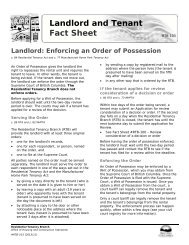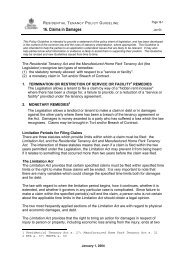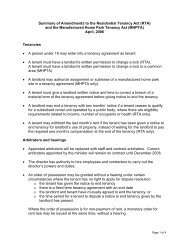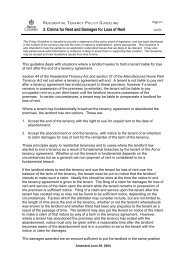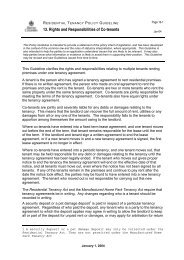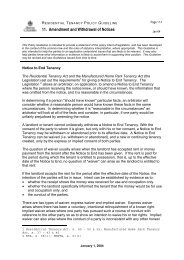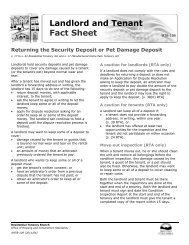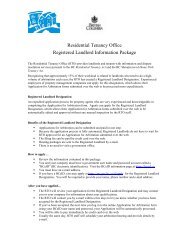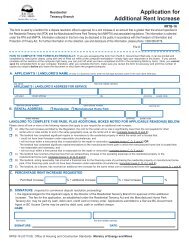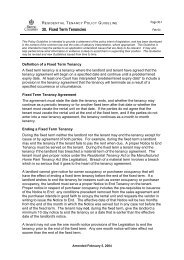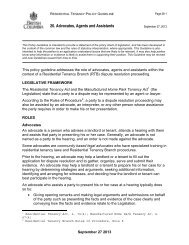37. Rent Increases - Residential Tenancy Office
37. Rent Increases - Residential Tenancy Office
37. Rent Increases - Residential Tenancy Office
Create successful ePaper yourself
Turn your PDF publications into a flip-book with our unique Google optimized e-Paper software.
RESIDENTIAL TENANCY POLICY GUIDELINE<br />
<strong>37.</strong> <strong>Rent</strong> <strong>Increases</strong><br />
Page 37-6<br />
Mar-12<br />
• a finding by an arbitrator that the landlord has failed to maintain or repair the property<br />
in accordance with the Legislation 6 ;<br />
• whether and to what extent an increase in costs, with respect to repair or<br />
maintenance of the property, results from inadequate repair or maintenance in the<br />
past;<br />
• whether a previously approved rent increase, or portion of a rent increase, was<br />
reasonably attributable to a landlord’s obligation under the Legislation that was not<br />
fulfilled;<br />
• whether an arbitrator has set aside a notice to end a tenancy within the preceding 6<br />
months; and<br />
• whether an arbitrator has found, in a previous application for an additional rent<br />
increase, that the landlord has submitted false or misleading evidence, or failed to<br />
comply with an arbitrator’s order for the disclosure of documents.<br />
An arbitrator’s examination and assessment of an AARI will be based significantly on the<br />
arbitrator’s reasonable interpretation of:<br />
• the application and supporting material;<br />
• evidence provided that substantiates the necessity for the proposed rent increase;<br />
• the landlord’s disclosure of additional information relevant to the arbitrator’s<br />
considerations under the applicable Regulation 7 ; and<br />
• the tenant’s relevant submission.<br />
Evidence regarding lack of repair or maintenance will be considered only where it is<br />
shown to be relevant to whether an expenditure was the result of previous inadequate<br />
repair or maintenance. A tenant’s claim about what a landlord has not done to repair<br />
and maintain the residential property may be addressed in an application for dispute<br />
resolution about repair and maintenance.<br />
Significantly lower rent 8<br />
The landlord has the burden and is responsible for proving that the rent for the rental unit<br />
is significantly lower than the current rent payable for similar units in the same<br />
geographic area. An additional rent increase under this provision can apply to a single<br />
unit, or many units in a building. If a landlord wishes to compare all the units in a<br />
building to rental units in other buildings in the geographic area, he or she will need to<br />
provide evidence not only of rents in the other buildings, but also evidence showing that<br />
the state of the rental units and amenities provided for in the tenancy agreements are<br />
comparable.<br />
The rent for the rental unit may be considered “significantly lower” when (i) the rent for<br />
the rental unit is considerably below the current rent payable for similar units in the same<br />
geographic area, or (ii) the difference between the rent for the rental unit and the current<br />
rent payable for similar units in the same geographic area is large when compared to the<br />
rent for the rental unit. In the former, $50 may not be considered a significantly lower<br />
6 RTA, s. 32; MHPTA, s. 26.<br />
7 RT Reg, s. 23; MHPT Reg, s. 33.<br />
8 RT Reg, s. 23(1)(a); MHPT Reg, s. 33(1)(a).<br />
Updated March 6, 2012



